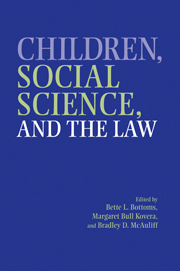Book contents
- Frontmatter
- Contents
- Acknowledgments
- Contributors
- 1 Children, Social Science, and the Law: An Introduction to the Issues
- PART I CHILDREN'S RIGHTS, THEIR CAPABILITIES, AND SOCIETY'S RESPONSIBILITIES TO CHILDREN
- PART II CHILDREN AND FAMILY CHANGE
- PART III JUVENILE AGGRESSION AND JUVENILE JUSTICE
- 9 Juvenile Transfer to Adult Court: How Can Developmental and Child Psychology Inform Policy Decision Making?
- 10 Youth Violence: Correlates, Interventions, and Legal Implications
- 11 Capacity, Competence, and the Juvenile Defendant: Implications for Research and Policy
- PART IV CHILDREN AS VICTIMS AND WITNESSES
- PART V CONCLUSIONS AND FUTURE DIRECTIONS
- Author Index
- Case Index
- Subject Index
- References
9 - Juvenile Transfer to Adult Court: How Can Developmental and Child Psychology Inform Policy Decision Making?
Published online by Cambridge University Press: 24 July 2009
- Frontmatter
- Contents
- Acknowledgments
- Contributors
- 1 Children, Social Science, and the Law: An Introduction to the Issues
- PART I CHILDREN'S RIGHTS, THEIR CAPABILITIES, AND SOCIETY'S RESPONSIBILITIES TO CHILDREN
- PART II CHILDREN AND FAMILY CHANGE
- PART III JUVENILE AGGRESSION AND JUVENILE JUSTICE
- 9 Juvenile Transfer to Adult Court: How Can Developmental and Child Psychology Inform Policy Decision Making?
- 10 Youth Violence: Correlates, Interventions, and Legal Implications
- 11 Capacity, Competence, and the Juvenile Defendant: Implications for Research and Policy
- PART IV CHILDREN AS VICTIMS AND WITNESSES
- PART V CONCLUSIONS AND FUTURE DIRECTIONS
- Author Index
- Case Index
- Subject Index
- References
Summary
A wave of youth violence and serious juvenile offending experienced in the mid-eighties and extending to the mid-nineties (Puzzanchera, 1998) left in its path legislation that reflected lawmakers' unwillingness to continue to back the rehabilitative policy of the juvenile justice system. Instead of supporting the rehabilitative model, lawmakers' response to the increase in juvenile violence was to alter the laws for prosecution of cases involving juvenile offenders. The most frequent alteration has been legislation that facilitates adolescents' prosecution under adult criminal laws. The mechanisms that allow for youths to be prosecuted under criminal laws are commonly known as waiver or transfer to adult court. Although the rates of violent juvenile offending have settled and even declined somewhat in the last few years (Sickmund, Snyder, & Poe-Yamagata, 1997), juveniles are increasingly treated as adults under the recent crime-control model.
Juvenile waiver to adult court has been an option almost since the inception of the juvenile justice system. In the past, however, juvenile transfers to adult court were based primarily on judicial discretion that considered differences in adolescents' dangerousness, sophistication-maturity, and amenability to treatment (Ewing, 1990; Grisso, 1998; Kruh & Brodsky, 1997; Salekin, Rogers, & Ustad, 2001). As such, juvenile court judges were required to make decisions on a case-by-case basis, considering the individual characteristics of adolescents before transferring youths to adult court. This process has changed substantially over the last decade, and legal reform has resulted in automatic and other transfer mechanisms of adolescents to adult criminal courts.
- Type
- Chapter
- Information
- Children, Social Science, and the Law , pp. 203 - 232Publisher: Cambridge University PressPrint publication year: 2002
References
- 7
- Cited by



